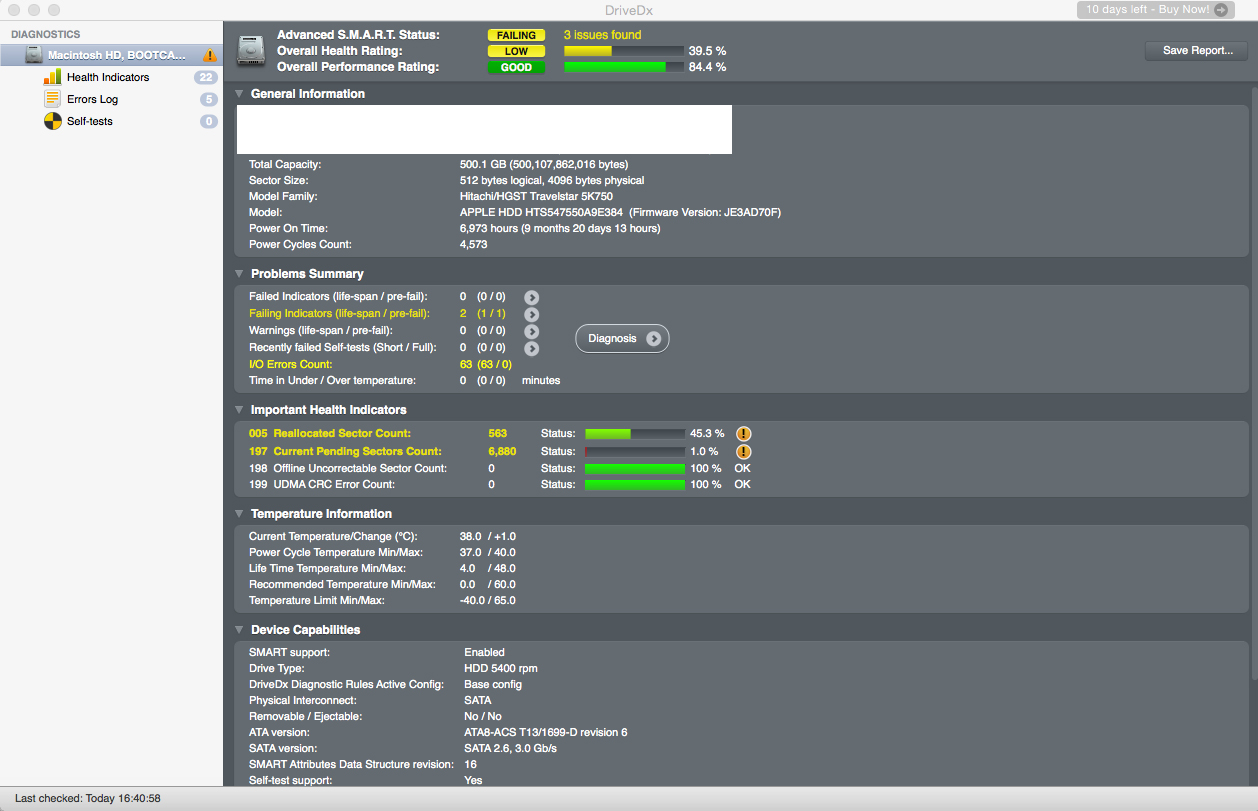Well Lets just say both tests say that my disk is "failing"....bummer.
I guess I have to take it in and get the hard drive replaced huh?

=== CURRENT POWER CYCLE STATISTICS ===
Data Read : 1.6 GB
Data Written : 3.1 GB
Data Read/Write Ratio : 0.51
Average Throughput (Read) : 529.3 KB/s
Average Throughput (Write) : 312.8 KB/s
Operations (Read) : 40,102
Operations (Write) : 72,273
Operations Read/Write Ratio : 0
Throughput per operation (Read) : 41.5 KB/Op
Throughput per operation (Write) : 45.1 KB/Op
Latency Time (Read) : 0 ns
Latency Time (Write) : 0 ns
Retries (Read) : 0
Retries (Write) : 0
Errors (Read) : 63
Errors (Write) : 0
=== PROBLEMS SUMMARY ===
Failed Indicators (life-span / pre-fail) : 0 (0 / 0)
Failing Indicators (life-span / pre-fail) : 2 (1 / 1)
Warnings (life-span / pre-fail) : 0 (0 / 0)
Recently failed Self-tests (Short / Full) : 0 (0 / 0)
I/O Errors Count : 63 (63 / 0)
Time in Under temperature : 0 minutes
Time in Over temperature : 0 minutes
=== IMPORTANT HEALTH INDICATORS ===
ID NAME RAW VALUE STATUS
5 Reallocated Sector Count 563 45.3% Failing
197 Current Pending Sectors Count 6,880 1.0% Failing
198 Offline Uncorrectable Sector Count 0 100% OK
199 UDMA CRC Error Count 0 100% OK
=== TEMPERATURE INFORMATION (CELSIUS) ===
Current Temperature : 38
Power Cycle Min Temperature : 37
Power Cycle Max Temperature : 40
Lifetime Min Temperature : 4
Lifetime Max Temperature : 48
Recommended Min Temperature : 0
Recommended Max Temperature : 60
Temperature Min Limit : -40
Temperature Max Limit : 65
=== DRIVE HEALTH INDICATORS ===
ID | NAME | TYPE | UPDATE | RAW VALUE | VALUE | THRESHOLD | WORST | STATUS
1 Raw Read Error Rate Pre-fail online 0x42C0000 77 62 77 39.5% OK
2 Throughput Performance Pre-fail offline 0 100 40 100 100% OK
3 Spin Up Time Pre-fail online 1 174 33 174 84.4% OK
4 Start Stop Count Life-span online 4,589 98 0 98 98.0% OK
5 Reallocated Sector Count Pre-fail online 563 48 5 48 45.3% Failing
7 Seek Error Rate Pre-fail online 0x0 100 67 100 100% OK
8 Seek Time Performance Pre-fail offline 0 100 40 100 100% OK
9 Power On Hours Life-span online 6,973 85 0 85 85.0% OK
10 Spin Retry Count Pre-fail online 0 100 60 100 100% OK
12 Power Cycle Count Life-span online 4,573 98 0 98 98.0% OK
160 Unknown Attribute Life-span online 0x0 100 0 100 100% OK
191 G-Sense Error Rate Life-span online 2 99 0 99 99.0% OK
192 Power-Off Retract Count Life-span online 0x53E00000051 93 0 93 93.0% OK
193 Load Cycle Count Life-span online 66,323 94 0 94 94.0% OK
194 Temperature (Celsius) Life-span online 38 157 0 157 78.5% OK
195 Hardware ECC Recovered Life-span online 0x49004E0 34 0 34 34.0% OK
196 Reallocated Event Count Life-span online 566 84 0 84 84.0% OK
197 Current Pending Sectors Count Life-span online 6,880 1 0 1 1.0% Failing
198 Offline Uncorrectable Sector Count Life-span offline 0 100 0 100 100% OK
199 UDMA CRC Error Count Life-span online 0 200 0 200 100% OK
223 Load Retry Count Life-span online 0 100 0 100 100% OK
254 Free Fall Sensor Life-span online 14,560 44 0 44 100% OK
=== DRIVE ERROR LOG ===
# | TIME OCCURRED | ERRORS | PRIOR COMMAND
5 6973 hours UNC READ DMA EXT
4 6973 hours UNC READ DMA EXT
3 6973 hours UNC READ DMA EXT
2 6973 hours UNC READ DMA EXT
1 6973 hours UNKNOWN ERROR READ FPDMA QUEUED
=== DRIVE SELF-TEST LOG ===
self-test log is empty